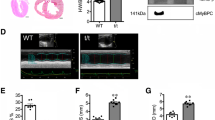Abstract.
Background: In congestive heart failure (CHF), function and metabolism of skeletal muscles are abnormal. Aim: To evaluate whether the reduced oxidative capacity of skeletal muscles in CHF is due to impaired O2 utilisation. Methods: CHF was induced in rats by injecting 50 mg/Kg monocrotaline. Several animals received the same dose of monocrotaline but only compensated right ventricular hypertrophy and no sign of congestion resulted. Two age- and diet-matched groups of control animals were also studied. In soleus and extensor digitorum longus (EDL) muscles, we studied skeletal muscle blood flow, oxidative capacity and respiratory function of skinned muscle fibres. Results: In CHF, we observed a decrease of muscle blood flow (statistically significant in the soleus, p < 0.05 vs. controls). In compensated rats, a similar trend in blood flow was observed. In both soleus and EDL, a significant reduction of high energy phosphate and a shift of the redox potential towards accumulation of reducing equivalents were observed. The reduction of energy charge was not correlated to the decrease of blood flow. In skinned myofibres, the ratio of O2 utilised in the presence and in absence of ADP (an index of phoshorilating efficiency) was reduced from 8.9 ± 1.9 to 2.7 ± 0.2 (p < 0.001) and from 5.7 ± 1.0 to 2.0 ± 0.3 (p < 0.01) in soleus and EDL, respectively. Activity of the different complexes of respiratory chain was investigated by means of specific inhibitors, showing major abnormalities at the level of complex I. In fact, inhibition of VO2 by rotenone was decreased from 83.5 ± 3.2 to 36.4 ± 9.6 % (p < 0.005) and from 81.8 ± 6.1 to 38.2 ± 7.4 % (p < 0.005) in soleus and EDL, respectively. Conclusions: In rats with CHF, abnormalities of oxidative phosphorylation of muscles occur and complex I of the respiratory chain seem to be primarily affected. The metabolic alterations of skeletal muscles in CHF may be explained, at least in part, by an impaired O2 utilisation.
Similar content being viewed by others
Author information
Authors and Affiliations
Additional information
Received: 22 February 2002, Returned for 1. revision: 14 March 2002, 1. Revision received: 5 June 2002, Returned for 2. revision: 21 June 2002, 2. Revision received: 23 August 2002, Accepted: 12 September 2002
Correspondence to: Dr. C. Ceconi
Rights and permissions
About this article
Cite this article
Bernocchi, P., Cargnoni, A., Vescovo, G. et al. Skeletal muscle abnormalities in rats with experimentally induced heart hypertrophy and failure. Basic Res Cardiol 98, 114–123 (2003). https://doi.org/10.1007/s003950300001
Issue Date:
DOI: https://doi.org/10.1007/s003950300001




